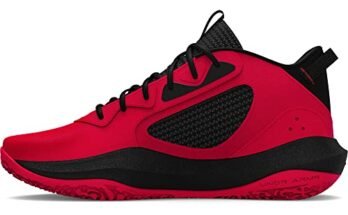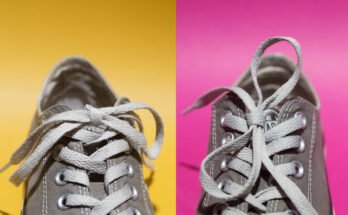Yes, basketball shoes can be used for volleyball due to similar lateral movement and traction needs. The supportive structure and cushioning of basketball shoes make them suitable for volleyball, providing stability and impact protection during quick movements and jumps on the court.
Volleyball and basketball involve similar lateral movements, quick stops, and jumps, making the footwear requirements quite similar for both sports. The sturdy construction and ankle support of basketball shoes can effectively cater to the demands of volleyball as well. Additionally, the cushioning and traction in basketball shoes offer the necessary stability and grip needed for the quick and dynamic movements inherent in volleyball.
This makes basketball shoes a viable option for volleyball players looking for supportive and durable footwear on the court.

Credit: www.youtube.com
Key Differences
When it comes to playing volleyball, it’s important to wear the right shoes that can provide the necessary support and traction. While basketball and volleyball shoes may look similar, there are key differences between the two that make them better suited for their respective sports. Here we will discuss the differences between basketball and volleyball shoes.
Sole Design And Traction
The sole design and traction of basketball shoes are mainly designed for the indoor basketball court. The sole of basketball shoes is typically flat, and the traction pattern is designed to provide excellent grip on the smooth and polished surface of the basketball court. On the other hand, volleyball shoes have a more curved sole design and a unique traction pattern that allows for quick lateral movements and jumping on the court. This is because volleyball courts are made of a different material that requires a different type of traction than basketball courts.
Weight And Ankle Support
Basketball shoes are generally heavier than volleyball shoes because basketball players need more support for their feet and ankles when they jump and land. Basketball shoes have a higher cut and provide more ankle support to help prevent injuries. On the other hand, volleyball shoes are designed to be lightweight and provide more freedom of movement for jumping and quick lateral movements. Volleyball shoes are also lower cut, providing less ankle support but more flexibility.
In conclusion, while basketball and volleyball shoes may look similar, they are designed with specific features that make them better suited for their respective sports. Basketball shoes are designed for the indoor basketball court and provide more support and traction, while volleyball shoes are designed for quick lateral movements and jumping on the volleyball court. So, it’s important to choose the right shoes for your sport to maximize your performance and reduce the risk of injury.
Impact On Performance
Basketball shoes can be used for volleyball, but their impact on performance may vary. While they offer good ankle support, the traction and cushioning might not be ideal for quick lateral movements on the volleyball court. It’s important to consider the specific needs of volleyball when choosing footwear.
Impact on Performance When it comes to sports, having the right gear is crucial for optimal performance. The choice of footwear, in particular, can significantly impact an athlete’s ability to excel in their sport. This is especially true when considering whether basketball shoes can be used for volleyball. Let’s delve into the impact of using basketball shoes for volleyball on key aspects of performance.Jumping Ability
The design of basketball shoes is tailored to enhance jumping ability. They often feature cushioning and support in the midsole to provide the necessary responsiveness and impact protection for basketball players. However, when used for volleyball, these same features can provide a valuable advantage, aiding in explosive jumps during spikes and blocks.Lateral Movements
Volleyball requires frequent and rapid lateral movements as players strive to cover the court effectively. Basketball shoes are crafted to support multidirectional movements, making them suitable for the lateral demands of volleyball. The traction patterns on the outsole of basketball shoes can aid in quick lateral shifts and provide stability during side-to-side movements on the court. In conclusion, while basketball shoes are designed for the specific needs of basketball players, they can be effectively utilized for volleyball, especially in terms of enhancing jumping ability and supporting lateral movements on the court.Injury Risks
When considering using basketball shoes for volleyball, it’s crucial to be aware of the potential injury risks. The design and construction of basketball shoes differ from those of volleyball shoes, which can impact an athlete’s performance and safety on the court.
Ankle Injuries
Basketball shoes are designed to provide enhanced ankle support and stability to protect players during rapid lateral movements and frequent jumping. While this design is beneficial for basketball, it may not be ideal for volleyball. Volleyball players require greater ankle flexibility and range of motion for efficient movement and maneuvers, which can be restricted by the high collars of basketball shoes. The reduced mobility can increase the risk of ankle injuries, especially during quick directional changes and lateral movements on the volleyball court.
Foot Discomfort
Wearing basketball shoes for volleyball can lead to foot discomfort and potential injuries due to the differences in cushioning and sole design. Basketball shoes typically have thicker and heavier soles to absorb the impact of frequent jumps and provide stability during landing. In contrast, volleyball shoes are designed with lighter and more responsive cushioning to facilitate quick movements and jumps on the court. The mismatch in cushioning and sole design can result in foot fatigue, discomfort, and a higher risk of overuse injuries for volleyball players.

Credit: live-bloginsider.mizunousa.com
Expert Recommendations
Basketball shoes can be used for volleyball, but it’s not ideal. Volleyball requires more lateral support and cushioning. Expert recommendations suggest opting for volleyball shoes for better performance and injury prevention on the court.
Podiatrists’ Advice
According to podiatrists, it is not recommended to use basketball shoes for volleyball. Basketball shoes are designed to provide more ankle support, which is not necessary for volleyball players. Moreover, basketball shoes are typically heavier than volleyball shoes, which can affect the player’s speed and agility on the court. Podiatrists recommend that volleyball players should wear shoes that are specifically designed for volleyball to avoid injury.Coaches’ Perspectives
Many coaches also suggest that basketball shoes should not be used for volleyball. As basketball shoes are heavier, they can slow down the player’s movements and affect their jumping ability. Volleyball shoes are lighter and more flexible, allowing players to move quickly and jump higher. Coaches often recommend that players wear shoes that are specifically designed for volleyball, as they provide the necessary support and traction for the sport.Conclusion
In conclusion, while basketball shoes may seem like a viable option for volleyball players, it is not recommended by experts. Podiatrists and coaches suggest that volleyball players wear shoes that are specifically designed for the sport to avoid injury and improve their performance on the court. Therefore, it is important to invest in a good pair of volleyball shoes to ensure a safe and enjoyable playing experience.Personal Experiences
Basketball shoes can be a viable option for volleyball, based on players’ testimonials. Many athletes find that basketball shoes provide good support and traction on the volleyball court.
Players’ Testimonials
- Comfortable for lateral movements
- Great ankle support during jumps
- Good traction on indoor courts
However, there are pros and cons to consider before using basketball shoes for volleyball. While some players enjoy the versatility of these shoes, others may find them lacking in specific volleyball-related features.
Pros And Cons
| Pros | Cons |
|---|---|
| Multi-purpose use | Lack of specialized cushioning |
| Excellent ankle support | Potential lack of breathability |
| Good traction | Heavier than dedicated volleyball shoes |
Credit: www.quora.com
Considerations Before Switching
Before switching basketball shoes for volleyball, consider the specific demands of each sport. Basketball shoes may offer good ankle support and cushioning, but they can be heavy and lack the lateral support needed for volleyball movements. It’s crucial to prioritize agility, stability, and traction on the volleyball court.
Playing Style
Court Surface
Frequently Asked Questions
Can You Play Volleyball In Basketball Shoes?
Yes, you can play volleyball in basketball shoes, but it’s not ideal for performance and safety. Volleyball shoes offer better support and traction.
Is There A Difference Between Volleyball And Basketball Shoes?
Volleyball and basketball shoes differ in design for specific sport needs, like jumping and lateral movements.
What Kind Of Shoes Should You Use For Volleyball?
For volleyball, use shoes with good ankle support, cushioning, and traction. Look for lightweight, breathable materials for comfort.
Are Volleyball Shoes Necessary?
Yes, volleyball shoes provide essential support and traction for the dynamic movements and jumps in the game. They help prevent injuries and improve performance.
Conclusion
Basketball shoes can be used for volleyball, but it’s not ideal. Consider the specific needs of each sport for optimal performance and injury prevention. Choose footwear that provides necessary support and traction for your game. Prioritize functionality and comfort for the best on-court experience.



